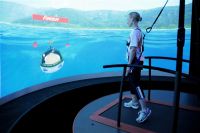BETHESDA, Md., June 28, 2010 — When the National Intrepid Center of Excellence opened its doors here last week, the sense of hope in reversing the rising tide of brain injuries and psychological illness in servicemembers was palpable.
From its warm design and family-friendly amenities to its best-in-the-world diagnostic and assessment equipment, the center boasts the convergence of art and science that officials hope will become the new normal in researching, diagnosing and treating traumatic brain injuries and post-traumatic stress disorder.
As Deputy Defense Secretary William J. Lynn III said at the center’s June 24 dedication ceremony, the need for such a center could not be more pressing. Hundreds of thousands of servicemembers are believed to have suffered TBIs and PTSD during their service in Afghanistan and Iraq, and many go undiagnosed, suffering the “invisible wounds” of war without explanation.
Gen. Peter Chiarelli, Army vice chief of staff, was asked during testimony before a U.S. Senate committee last week why the military cannot better diagnose brain injuries and PTSD. “I promise you it is not from lack of trying,” he said. “We are doing everything we can.”
That’s where the Intrepid Center comes in. Not a clinical care hospital, the center instead is designed to accept on referral those military members whom the services struggle to help, those whose injuries are so elusive to not be detected, or that are unresponsive to treatment developed at base hospitals, which are lacking in proper equipment, staffing and expertise, officials said during a June 23 media event.
The Intrepid Center holds the promise of proper diagnosis and treatment plans for those toughest cases. The $65 million center on the grounds of the National Naval Medical Center houses $10 million in equipment, much of it unique to the center and a handful of academic research institutes.
It includes brain imaging equipment that produces up to 6,000 images per brain scan, Dr. Gerard Riedy, the center’s chief of neurology, said. While standard magnetic resonance imaging equipment allows for about 750 images mostly showing the outside structure of the brain, Riedy said, the center’s three-dimensional imaging equipment shows everything from lesions of mild TBI on the brain’s surface to internal brain functions, seen in real time.
“It’s all non-invasive,” Riedy explained from the center’s “visualization” room, surrounded by a large, 3‑dimensional screen and multiple smaller screens showing brain images. While a patient undergoes what seems like a standard MRI or positron emission tomography or CT scans in another room, Riedy and his staff of six assess color-coded images of the brain’s magnetic fields, wiring, and the like. One screen displays the brain activity when the patient is asked to do certain tasks, allowing doctors to assess proper functioning, including psychological stress.
Riedy said his staff with be interoperable, meaning they will process scans from military facilities and share their discoveries and observations. “This stuff is not easy to do,” he noted, “and I have six people working for me.”
Down the hall from the brain imaging room, patients may enter virtual reality suites where they can be assessed on their reaction to being fully immersed -– smells of burning rubber or dead bodies included — in recreated scenes from Iraq or Afghanistan. Or researchers or clinicians may test their driving or shooting ability in simulators for their possible return to duty.
In another room, a patient may walk or run on a treadmill suspended on a moving platform surrounded by any number of scenes that staffers create, from a street scene in Baghdad to a fishing pond in Idaho. The patient’s reactions to given tasks allows staff to assess functions such as balance, coordination, multitasking, reaction times and visual acuity, said Johanna Bell, an operator of the Computer-Assisted Rehabilitation Environment, or CAREN, machine.
Such equipment may provide the missing link in proper diagnosis and treatment.
“We’ve got no other objective measures of TBI right now,” Riedy said. Servicemembers take written tests when returning from deployment, but those aren’t conclusive in the ways of brain scans and virtual reality equipment.
Still, expensive equipment alone won’t solve the problem of TBI and psychological illness in servicemembers. The center’s staff also offers hope of improved care, not only with their understanding of the science and equipment, but also in the art of working with and understanding patients.
“A lot of these patients just need an understanding that they are not crazy,” said Army Lt. Col. Matthew St. Laurent, assistant chief of occupational therapy at Walter Reed Army Medical Center in Washington, D.C. “There’s something wrong in their brain tissue.”
St. Laurent said he is honored to be associated with the center, which he called “a place for us to come and learn” about the nascent science of combat-related TBI.
In a second-floor open area surrounded by windows and flooded with natural light, St. Laurent and others can assess patients on various types of exercise equipment to measure their ability to push, pull, carry, lift and perform other basic functions.
A few steps away, patients can open a door into the center’s “Central Park,” a circular refuge of tranquility with skylights, green plants and park benches. Displaying the center’s openness for alternative therapies – in this case, ambient therapy — the room’s floor is a labyrinth of two-toned, polished wood, inviting its guests to relax or confront their troubles on its winding paths.
From the best diagnostic and imaging equipment to the desire to make military families comfortable and engaged, staff members are clear about their goals.
“Our ultimate goal is to get our military men and women back to duty,” St. Laurent said.
Source:
U.S. Department of Defense
Office of the Assistant Secretary of Defense (Public Affairs)

 von
von 